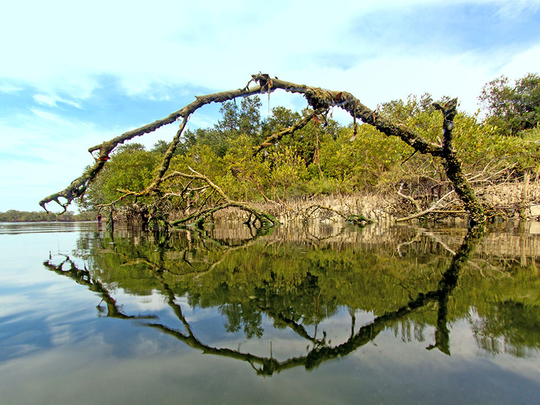
Abu Dhabi: The emirate has detected a decline of less than one per cent of its natural habitats on average during the past five years, including the most critical and environmentally sensitive ones.
This was found in a just completed assessment of the emirate’s natural habitats, which evaluated their health and maintenance from 2013 until now, said the Environment Agency — Abu Dhabi (EAD).
Areas assessed included the mountain and wadi habitats of Al Ain region, coastal and inland desert areas in Al Dhafra region and the mangroves of Abu Dhabi city.
- Razan Khalifa Al Mubarak | EAD secretary-general
“This is a very positive result for the emirate’s environmentally critical terrestrial and coastal areas,” said Razan Khalifa Al Mubarak, EAD Secretary General.
Abu Dhabi is home to over 3,600 known species, with more being discovered each day by the scientists.
“The best way to ensure their continued protection is by safeguarding the habitats they rely on for food, shelter and survival. The majority of Abu Dhabi’s key species such as the vulnerable Sooty Falcon and Arabian Oryx, the endangered Arabian Tahr, and the critically endangered Hawksbill Turtle depend on these habitats to survive,” Al Mubarak said.
EAD is responsible for managing and conserving the emirate’s fragile habitats, and committed to achieving the Abu Dhabi Government’s goal of protecting at least 80 per cent of all its natural terrestrial and marine habitats.
Rapid industrial and urban development are drivers of habitat loss locally and globally, further exacerbated by the effects of climate change and significantly impacting biodiversity, the official noted.
The assessment relied on one of the most extensive and detailed habitat maps in the world developed by EAD in 2014, available on enviroportal.ead.ae. For the assessment, the agency adopted an innovative approach of digitally assessing satellite imagery to identify changes in land use from 2013 until now, and then evaluated how well maintained the emirate’s most precious natural areas are.
“The responsibility for the environment is a collective one and this outcome is a result of a strong partnership with the Department of Urban Planning and Municipalities, Abu Dhabi, Al Ain and Al Dhafra Municipalities and the Department of Transport,” Al Mubarak said.
“These collaborations have helped ensure that we meet the emirate’s ambitious commitments for sustainable growth and the protection of our natural heritage. We need to continue these types of collaborations so that the environment remains a key consideration in land use planning across the Emirate,” she said.
The EAD was established in 1996 to preserve Abu Dhabi’s natural heritage, protect its future, and raise awareness about environmental issues. As Abu Dhabi’s environmental regulator, it advises the government on environmental policy.
Guideline helps developers avoid impact to habitats
A guideline developed by scientists at the Environment Agency — Abu Dhabi (EAD) serves as a management tool to help developers plan projects in a manner that avoids impacting the emirate’s critical natural habitats.
The people, government and private sectors get an insight into Abu Dhabi’s habitats from the guideline, that aims at prioritising its marine and terrestrial habitats.
Anyone can download the ‘Abu Dhabi Habitat Classification and Protection Guideline’ from www.ead.ae and learn more.
Many of the emirate’s known species are facing visible pressure from urbanisation and the rapid development of industry and infrastructure to support the emirate’s growing population and its demand for power, transport and land.
The document gives guidance about habitats that are classified as critical or environmentally sensitive.
The guideline also offers directions on terrestrial and marine habitat protection, mitigation and monitoring for projects carried out in the marine and terrestrial environment of the emirate. It helps inform project proponents and project consultants, and limit habitat degradation, fragmentation and loss.
FIGURES AND FACTS
■ 1% decline in natural habitat in 5 years
■ 99% critical habitats are protected
■ 3,600 known species in Abu Dhabi emirate
■ 80% of all natural habitats to be protected as per Abu Dhabi Government’s goal
Highlights
■ 5-year long assessment was carried out in the mountain and wadi habitats of Al Ain region, coastal and inland desert areas in Al Dhafra region and Abu Dhabi city’s mangroves
■ Key species such as the Sooty Falcon, Arabian Tahr, Arabian Oryx and Hawksbill Turtle survive in critical and sensitive habitats
■ EAD digitally assessed satellite imagery to identify changes in land use from 2013 to mid-2018












